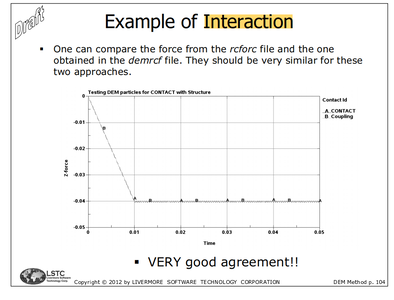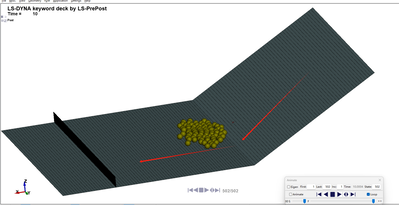Hello
I am currently working with DEM–structure interaction models using *DEFINE_DE_TO_SURFACE_COUPLING, and I’ve encountered a persistent and fundamental discrepancy between two output forces:RCFORC and DEMRCFORC.
In my model:
-
DEM particles fall under gravity and settle onto a flat structure surface
-
At final steady state, only one single layer of DEM particles remains in contact with the structure
-
There are no inter-particle contacts active, and DEM motion has ceased
Under such conditions, I expect the vertical force in demrcf (Z-direction) to match the total weight of DEM particles (since this is the only external vertical load), and to be consistent with rcforc.
However, I consistently observe the following:
-
RCFORC(Z-component) ≈ total weight of DEM particles → reasonable -
DEMRCFORC(Z-component) is 2–3 orders of magnitude smaller thanRCFORC→ unexpected
My key questions are:
-
What exactly does
demrcf(DEMRCFORC) represent in terms of contact force physics? -
Does it include the total contribution from all DEM particles in contact with the structure?
-
Could DEM–DEM interactions indirectly affect the value in
demrcf(e.g., via force chains)? -
Is this output known to be partial (e.g., segment-level only), and not a full sum over all particle contributions?
-
In such scenarios, is
rcforcthe more reliable quantity to assess the net force on the structure? - Furthermore, in the documentation titled “DEM_method_LS_DYNA_draft_mrj_09_10_12.pdf”, there is an example showing that the
RCFORCandDEMRCFORCoutputs match closely in a simple case, where DEM particles settle on a surface. However, in my case, despite using similar conditions (gravity loading, full contact, final static state), the two force outputs are very different, particularly in the Z-direction.
Thank you in advance for your time and support!
The left image is from the documentation, and the right image is from my model.


